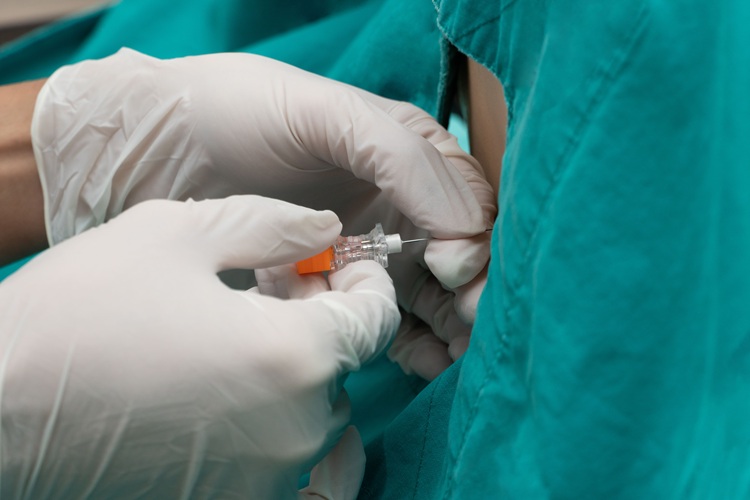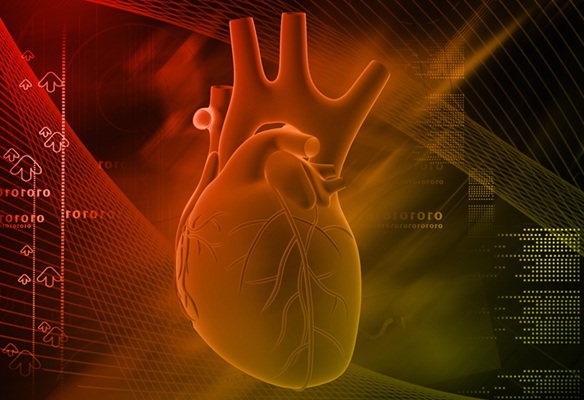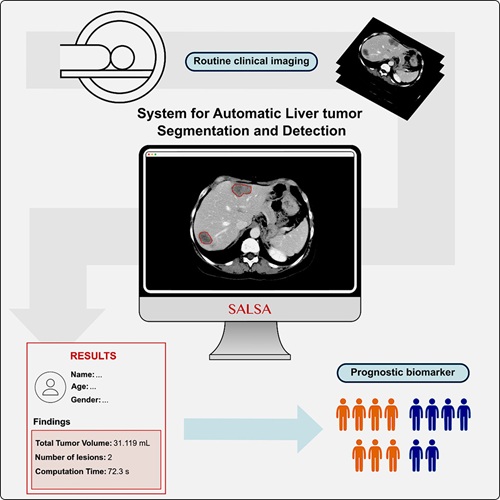Telerobotic Approach Provides Virtual Ultrasound Evaluations for Physicians, Hospitals, and Communities
|
By MedImaging International staff writers Posted on 26 Aug 2014 |
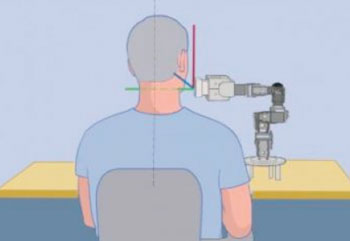
ge: Graphic of the way trans-Atlantic robot-assisted ultrasound is performed (Photo courtesy of Mount Sinai).
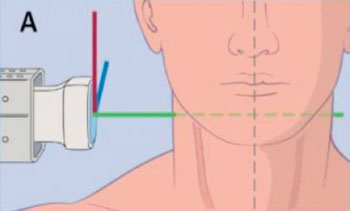
Image: Graphic of where the new tele-robotic ultrasound used to perform a carotid artery exam is placed (Photo courtesy of Mount Sinai).
An American physician, while in Germany, used a computer to perform a robot-assisted transatlantic ultrasound exam on a person in Boston (MA, USA). In another study, a Swedish doctor, working in collaboration with another physician, showed how a cardiologist’s video e-consultation, combined with a remote robot-assisted echocardiogram test, can drastically lessen the waiting time for a diagnosis faced by heart failure patients who live in a rural communities far from the hospital from nearly four months to less than one month.
These research studies were published in the August 2014 issue of the Journal of the American College of Cardiology-Imaging. “The two studies give us a glimpse of what to expect in the near future, a patient-friendly imaging technology at your doorstep,” said Jagat Narula, MD, PhD, senior author of both research studies who serves as the director of the Mount Sinai Cardiovascular Imaging Center and associate dean of global research at Icahn School of Medicine at Mount Sinai (New York, NY, USA).
“These studies lift the robotic imaging and telemedicine to the next level,” remarked Sherif F. Nagueh, MD, medical director of the echocardiography laboratory at the Methodist DeBakey Heart and Vascular Center (Houston, TX, USA), who authored the accompanying editorial about the two studies in JACC-Imaging.
“Our first-in-man experiment shows long-distance, telerobotic ultrasound examinations over standard internet are possible,” said Partho P. Sengupta, MD, who is director of cardiac ultrasound research at Icahn School of Medicine at Mount Sinai, and chair of the new technology Task Force at the American Society of Echocardiography. “Our successful experiment opens up a new frontier for the use of remote, robotic ultrasound imaging that could potentially be more efficient and cost-effective overall for healthcare access and delivery.”
In the first study, lead investigator Dr. Sengupta and researchers assessed the use of a small, lightweight robotic-arm with built-in ultrasound technology located in Boston and connected to a personal computer (PC) with a low-bandwidth Internet connection in Munich, Germany. The robotic ultrasound exam of an individual’s carotid artery in their neck was completed in just four minutes.
“This feasibility and time-efficiency of long-distance, telerobotic ultrasound may help expand the role of imagers to care for patients online virtually lending a true ‘helping hand’ remotely and providing a patient’s care team expert guidance,” said Mount Sinai’s Dr. Sengupta. Significantly, in the study experiments, both advanced specialists and early trainees on robotic ultrasound were able to operate the telerobotic technology.
In the second study, Kurt Boman, MD, of Umea University (Umea, Sweden) and colleagues randomized half their study patients to remote consultation and the other half to standard of care referral to the hospital. Remote consultation and the robotic echocardiogram exam were conducted on the same day of a patient’s visit to their local Primary healthcare center located more than 100 miles away from the hospital. Study results show, the total diagnostic process time was greatly decreased from 114 to 27 days in those patients receiving remote consultation. Furthermore, the patient’s wait time until obtaining a specialist consultation was reduced from 86 to 12 days, with 95% of remote consult patients claiming remote consult to be a superior strategy.
“As a result of our pilot study, we were able to establish a safe and efficient e-health solution to improve the comprehensive, convenient examination of suspected heart failure patients in a rural community of northern Sweden and improve their physician care team's communication,” stated Dr. Narula of Mount Sinai. “This pilot study may serve as a future model for use of e-consults and robotic imaging in similar rural communities to improve access to specialists and the latest diagnostic technology globally.”
“In clinical medicine, the use of more portable low-cost, safe, non-radiation using ultrasound imaging technology is growing for diagnosis, patient monitoring, and procedural, and surgical planning,” commented Valentin Fuster, MD, PhD, director of Mount Sinai Heart at Icahn School of Medicine at Mount Sinai and the new editor-in-chief of the Journal of the American College of Cardiology (JACC). “The technology may be key to accelerating greater local and global healthcare access more efficiently and cost-effectively for patients, doctors, communities, and hospitals in need.”
According to researchers, on-demand, virtual robotic ultrasound could be used in a wide variety of clinical setting collaborations ranging from in-hospital or emergency room patient imaging studies, community screenings, or even within hazardous sites such as war zones.
Related Links:
Icahn School of Medicine at Mount Sinai
Umea University
These research studies were published in the August 2014 issue of the Journal of the American College of Cardiology-Imaging. “The two studies give us a glimpse of what to expect in the near future, a patient-friendly imaging technology at your doorstep,” said Jagat Narula, MD, PhD, senior author of both research studies who serves as the director of the Mount Sinai Cardiovascular Imaging Center and associate dean of global research at Icahn School of Medicine at Mount Sinai (New York, NY, USA).
“These studies lift the robotic imaging and telemedicine to the next level,” remarked Sherif F. Nagueh, MD, medical director of the echocardiography laboratory at the Methodist DeBakey Heart and Vascular Center (Houston, TX, USA), who authored the accompanying editorial about the two studies in JACC-Imaging.
“Our first-in-man experiment shows long-distance, telerobotic ultrasound examinations over standard internet are possible,” said Partho P. Sengupta, MD, who is director of cardiac ultrasound research at Icahn School of Medicine at Mount Sinai, and chair of the new technology Task Force at the American Society of Echocardiography. “Our successful experiment opens up a new frontier for the use of remote, robotic ultrasound imaging that could potentially be more efficient and cost-effective overall for healthcare access and delivery.”
In the first study, lead investigator Dr. Sengupta and researchers assessed the use of a small, lightweight robotic-arm with built-in ultrasound technology located in Boston and connected to a personal computer (PC) with a low-bandwidth Internet connection in Munich, Germany. The robotic ultrasound exam of an individual’s carotid artery in their neck was completed in just four minutes.
“This feasibility and time-efficiency of long-distance, telerobotic ultrasound may help expand the role of imagers to care for patients online virtually lending a true ‘helping hand’ remotely and providing a patient’s care team expert guidance,” said Mount Sinai’s Dr. Sengupta. Significantly, in the study experiments, both advanced specialists and early trainees on robotic ultrasound were able to operate the telerobotic technology.
In the second study, Kurt Boman, MD, of Umea University (Umea, Sweden) and colleagues randomized half their study patients to remote consultation and the other half to standard of care referral to the hospital. Remote consultation and the robotic echocardiogram exam were conducted on the same day of a patient’s visit to their local Primary healthcare center located more than 100 miles away from the hospital. Study results show, the total diagnostic process time was greatly decreased from 114 to 27 days in those patients receiving remote consultation. Furthermore, the patient’s wait time until obtaining a specialist consultation was reduced from 86 to 12 days, with 95% of remote consult patients claiming remote consult to be a superior strategy.
“As a result of our pilot study, we were able to establish a safe and efficient e-health solution to improve the comprehensive, convenient examination of suspected heart failure patients in a rural community of northern Sweden and improve their physician care team's communication,” stated Dr. Narula of Mount Sinai. “This pilot study may serve as a future model for use of e-consults and robotic imaging in similar rural communities to improve access to specialists and the latest diagnostic technology globally.”
“In clinical medicine, the use of more portable low-cost, safe, non-radiation using ultrasound imaging technology is growing for diagnosis, patient monitoring, and procedural, and surgical planning,” commented Valentin Fuster, MD, PhD, director of Mount Sinai Heart at Icahn School of Medicine at Mount Sinai and the new editor-in-chief of the Journal of the American College of Cardiology (JACC). “The technology may be key to accelerating greater local and global healthcare access more efficiently and cost-effectively for patients, doctors, communities, and hospitals in need.”
According to researchers, on-demand, virtual robotic ultrasound could be used in a wide variety of clinical setting collaborations ranging from in-hospital or emergency room patient imaging studies, community screenings, or even within hazardous sites such as war zones.
Related Links:
Icahn School of Medicine at Mount Sinai
Umea University
Latest Ultrasound News
- New Incision-Free Technique Halts Growth of Debilitating Brain Lesions
- AI-Powered Lung Ultrasound Outperforms Human Experts in Tuberculosis Diagnosis
- AI Identifies Heart Valve Disease from Common Imaging Test
- Novel Imaging Method Enables Early Diagnosis and Treatment Monitoring of Type 2 Diabetes
- Ultrasound-Based Microscopy Technique to Help Diagnose Small Vessel Diseases
- Smart Ultrasound-Activated Immune Cells Destroy Cancer Cells for Extended Periods
- Tiny Magnetic Robot Takes 3D Scans from Deep Within Body
- High Resolution Ultrasound Speeds Up Prostate Cancer Diagnosis
- World's First Wireless, Handheld, Whole-Body Ultrasound with Single PZT Transducer Makes Imaging More Accessible
- Artificial Intelligence Detects Undiagnosed Liver Disease from Echocardiograms
- Ultrasound Imaging Non-Invasively Tracks Tumor Response to Radiation and Immunotherapy
- AI Improves Detection of Congenital Heart Defects on Routine Prenatal Ultrasounds
- AI Diagnoses Lung Diseases from Ultrasound Videos with 96.57% Accuracy
- New Contrast Agent for Ultrasound Imaging Ensures Affordable and Safer Medical Diagnostics
- Ultrasound-Directed Microbubbles Boost Immune Response Against Tumors
- POC Ultrasound Enhances Early Pregnancy Care and Cuts Emergency Visits
Channels
Radiography
view channel
Machine Learning Algorithm Identifies Cardiovascular Risk from Routine Bone Density Scans
A new study published in the Journal of Bone and Mineral Research reveals that an automated machine learning program can predict the risk of cardiovascular events and falls or fractures by analyzing bone... Read more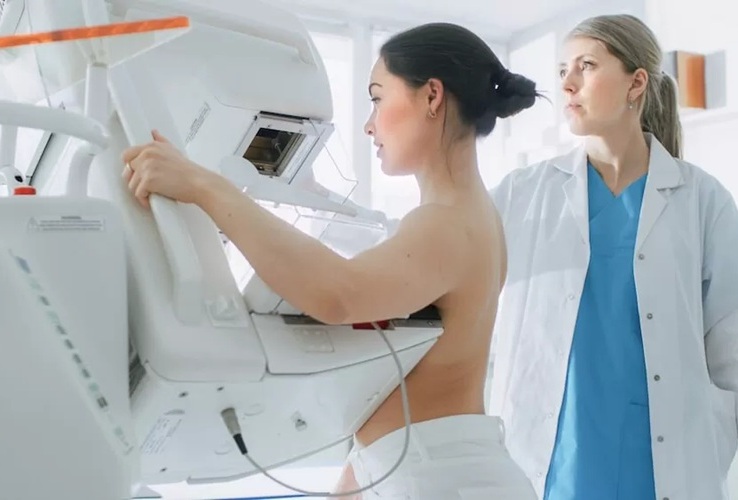
AI Improves Early Detection of Interval Breast Cancers
Interval breast cancers, which occur between routine screenings, are easier to treat when detected earlier. Early detection can reduce the need for aggressive treatments and improve the chances of better outcomes.... Read more
World's Largest Class Single Crystal Diamond Radiation Detector Opens New Possibilities for Diagnostic Imaging
Diamonds possess ideal physical properties for radiation detection, such as exceptional thermal and chemical stability along with a quick response time. Made of carbon with an atomic number of six, diamonds... Read moreMRI
view channel
New MRI Technique Reveals Hidden Heart Issues
Traditional exercise stress tests conducted within an MRI machine require patients to lie flat, a position that artificially improves heart function by increasing stroke volume due to gravity-driven blood... Read more
Shorter MRI Exam Effectively Detects Cancer in Dense Breasts
Women with extremely dense breasts face a higher risk of missed breast cancer diagnoses, as dense glandular and fibrous tissue can obscure tumors on mammograms. While breast MRI is recommended for supplemental... Read moreNuclear Medicine
view channel
New Imaging Approach Could Reduce Need for Biopsies to Monitor Prostate Cancer
Prostate cancer is the second leading cause of cancer-related death among men in the United States. However, the majority of older men diagnosed with prostate cancer have slow-growing, low-risk forms of... Read more
Novel Radiolabeled Antibody Improves Diagnosis and Treatment of Solid Tumors
Interleukin-13 receptor α-2 (IL13Rα2) is a cell surface receptor commonly found in solid tumors such as glioblastoma, melanoma, and breast cancer. It is minimally expressed in normal tissues, making it... Read moreGeneral/Advanced Imaging
view channel
First-Of-Its-Kind Wearable Device Offers Revolutionary Alternative to CT Scans
Currently, patients with conditions such as heart failure, pneumonia, or respiratory distress often require multiple imaging procedures that are intermittent, disruptive, and involve high levels of radiation.... Read more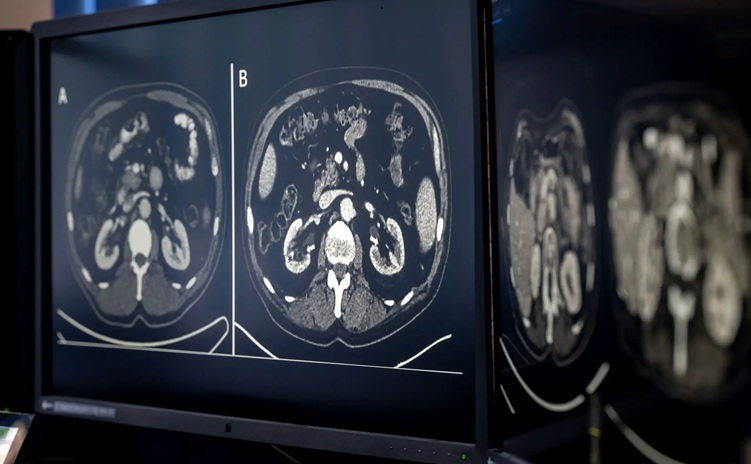
AI-Based CT Scan Analysis Predicts Early-Stage Kidney Damage Due to Cancer Treatments
Radioligand therapy, a form of targeted nuclear medicine, has recently gained attention for its potential in treating specific types of tumors. However, one of the potential side effects of this therapy... Read moreImaging IT
view channel
New Google Cloud Medical Imaging Suite Makes Imaging Healthcare Data More Accessible
Medical imaging is a critical tool used to diagnose patients, and there are billions of medical images scanned globally each year. Imaging data accounts for about 90% of all healthcare data1 and, until... Read more
Global AI in Medical Diagnostics Market to Be Driven by Demand for Image Recognition in Radiology
The global artificial intelligence (AI) in medical diagnostics market is expanding with early disease detection being one of its key applications and image recognition becoming a compelling consumer proposition... Read moreIndustry News
view channel
GE HealthCare and NVIDIA Collaboration to Reimagine Diagnostic Imaging
GE HealthCare (Chicago, IL, USA) has entered into a collaboration with NVIDIA (Santa Clara, CA, USA), expanding the existing relationship between the two companies to focus on pioneering innovation in... Read more
Patient-Specific 3D-Printed Phantoms Transform CT Imaging
New research has highlighted how anatomically precise, patient-specific 3D-printed phantoms are proving to be scalable, cost-effective, and efficient tools in the development of new CT scan algorithms... Read more
Siemens and Sectra Collaborate on Enhancing Radiology Workflows
Siemens Healthineers (Forchheim, Germany) and Sectra (Linköping, Sweden) have entered into a collaboration aimed at enhancing radiologists' diagnostic capabilities and, in turn, improving patient care... Read more












